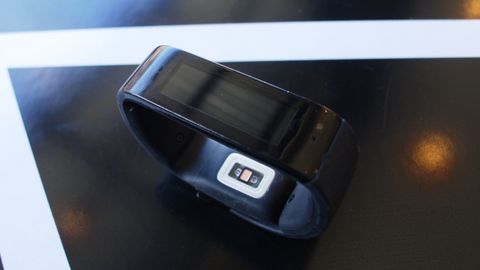Why you can trust TechRadar
More apps would be a boon for the Microsoft Band, because there aren't very many right now. It's nice how you can sync up so much data from other apps, but do I really want to have five different app accounts along with all my Band fitness data? Not really. I wasn't using the partnered apps in the first place and I didn't really feel like downloading them.
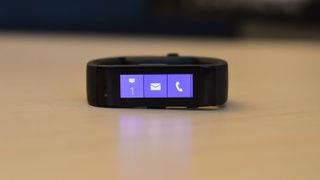
Microsoft offers 17 stock tiles, or apps, you can mix and match from the Microsoft Health app. Of the 17, you can choose 13 to display on the band.
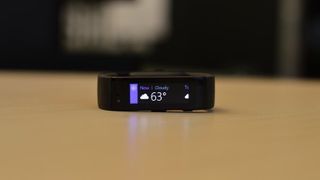
Your options are the run of the mill apps: messaging, mail, calls, calendar, run, exercise, sleep, alarm/timer, guided workouts, cycling, weather, finance, UV, Starbucks, Facebook, Facebook Messenger, Twitter and a notification center. You can also sync up the UP by Jawbone app, Runkeeper, MapMyFitness and MyFitnessPal so Microsoft Health app has more info on you.
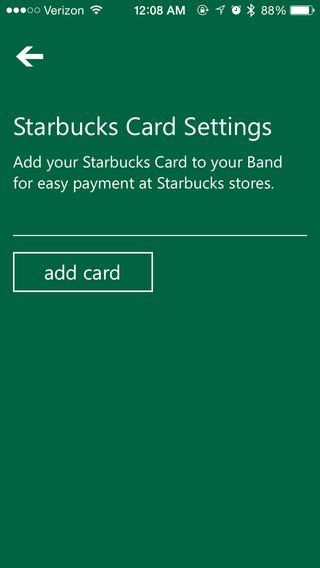
There are a few random ones, like UV which takes a reading - low, moderate, high, very high, no UV - of the UV rays when you're outside. While fun to try, it gets old after using it once. It seems a little unnecessary since it doesn't really do anything - it's pretty obvious if you're being exposed to too much sun.
The Starbucks app is pretty neat in that it stores the barcode of a gift card for easy access when you're the cafe. You can only store one card at a time though.
Fitness
This wearable was basically made to make you an exercise machine. There are so many sensors and apps dedicated to fitness, it's kind of crazy, if verging on excessive. However, it's definitely been fun using them all (and painful realizing how out of shape I am).
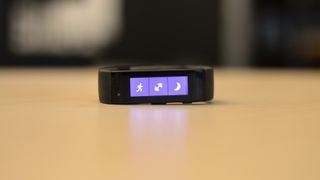
My favorite fitness feature is the guided workouts app. In the US Microsoft partnered with Gold's Gym, Shape, Men's Fitness and more to compile a series of workouts that you can "download" to your band. For the UK it's teamed up with Nuffield Health.
It's not as fancy as it sounds, but it gets the job down. Essentially you pick whatever workout you want from the Microsoft Health app under "Find a workout." These range from activities under running, bodyweight and strength categories that last for five minutes to an hour and incorporate different reps.

I chose a 14-minute beginner's crunch and plank routine to start with. The app synced with my band and after choosing the tile, it would start the timer and I would begin the workout. After each rep, the haptics would buzz, letting me know there would be a moment to rest, then it would buzz again beginning the next set.
If you aren't sure how to do an exercise, there are short videos that accompany each workout that you can watch from you phone beforehand. It's a barebones way to exercise, but easy and great for people like me who prefer to keep an already arduous chore as hassle free as possible.
Since launching, five new indoor biking workouts have been added to the Guided Workouts app, including: Indoor Bike Tabata Sprints, Indoor Bike Hour of Sweat, Indoor Bike Total Body, Indoor Bike Pyramid and Indoor Bike Intervals.
A completely new Bike app has been added to the band's exercise-heavy roster as well. It lets you track your rides outdoors, or indoors if you prefer, hence the new guided workouts. When the Bike tile is active, the heart rate monitor becomes "optimized specifically for biking activities."
It can also track elevation and elevation gain, distance and duration and calorie burn which is viewable in the Microsoft Health app. Plus, you map out your ride via GPS, track your current and average speeds both on the band and in the mobile app, and review your custom splits and see an estimate for how long it will take your body to recover from the ride.
The running app is even simpler. All you have to do is select it, and it begins a timer. Keeping the GPS on measures the distance you've run and tracks your pace and route. the app can also retrace your steps, so you can challenge yourself later. The metrics then show up on the band under the Run app and on your mobile device.
You can also measure yoga sessions, weight lifting and cycling. Basically, Microsoft is trying to say the Band can do everything to make you the most macho, buff, fit person ever.
In fact, the Microsoft Health platform has been touted as being an actual service that uses a series of algorithms to collect the data you input from the Band, and even Jawbone or Runkeeper, etc. It then continuously changes up routines, tells you different things and so forth to help motivate you.
Most of the sensors are used when you're exercising to give you the fullest picture of well, you. But it's not quite there yet … I was expecting a lot more from what Microsoft has plugged about the platform. I even downloaded and signed up for the partnered accounts, but it's been disappointing so far.
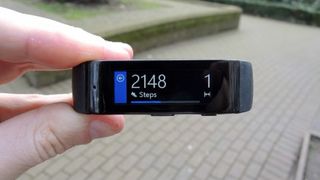
Just like the lack of apps, it's too early for the Health app to really work. Where are the suggestions to help motivate me? I was expecting some sort of creepy AI to be my personal trainer and yell at me (through haptic feeds and text messages or something) to get my lazy bum away from Netflix binging and into a pair of running shoes. OK, maybe that's wishing for too much, but Microsoft did promise "valuable, personal insights" to help me reach my fitness goals.
The Microsoft Band webpage reads, "Built in the cloud, Microsoft Health will continually evolve to offer you better experiences and more valuable data over time. The more you share with Microsoft Health, the more accurate and helpful your insights will become."
Again, what insights? The graphs that charted my sleep and exercising have been great so far, but where's the part where Microsoft said it would help me be a healthier person? Apparently it's not ready yet.
I spoke with Zulfi Alam, General Manager of Personal Devices at Microsoft about the lack of solid data from insights. He said that the new update with the Band is the first step in creating a wider net to catch more information because the "back engine needs rich data, and thousands of users are needed to generate this." In other words, the more people who use the fitness tracker and fill it with data, the more we'll actually see the insights with heightened accuracy.
One of the ways Microsoft plans on helping you glean more information? The Microsoft HealthVault - which is now connected to your Band. Data from the wearable, including workout and sleep info, is automatically uploaded to the HealthVault account - which you should be able to log into with the same credentials used for the Band. According to Microsoft, the HealthVault is supposed to help you organize your health information in one place, and help gather, store, use, and share information and records with healthcare providers. To link a Microsoft HealthVault account to Microsoft Health data, simply go to "Connected Apps" in the menu of the Microsoft Health app.

Microsoft Health Web Dashboard has also been added as an upgrade. The web dashboard is basically a bigger version of the information stored in your mobile app but it can be accessed through any web browser.
Current page: Apps and fitness
Prev Page Specs, performance and interface Next Page Compatibility and battery lifeCameron is a writer at The Verge, focused on reviews, deals coverage, and news. He wrote for magazines and websites such as The Verge, TechRadar, Practical Photoshop, Polygon, Eater and Al Bawaba.
